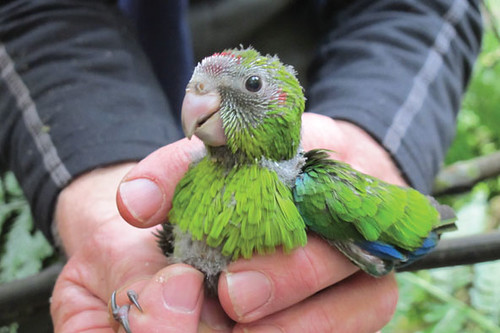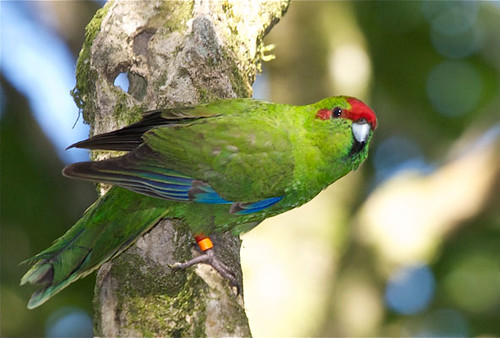 Red-crowned parakeets are bringing a dash of colour to NZ capital city once again.The cheerful kākāriki is making a return to Wellington thanks to a successful transfer and monitoring program at Zealandia.
Red-crowned parakeets are bringing a dash of colour to NZ capital city once again.The cheerful kākāriki is making a return to Wellington thanks to a successful transfer and monitoring program at Zealandia.
Though occasional sightings had been made in and around the sanctuary there had been no sign of a sustained parakeet population since the late 1800s. Kākāriki habitat has been vastly reduced over the last century and predation by introduced mammals in unprotected areas significantly affects survival.
In July 2010 a transfer of the colourful birds was made from Kapiti Island to Zealandia, with support from the Pharazyn Trust; two more transfers followed in May and July 2011. The sanctuary kākāriki have now increased their known breeding pair numbers from six in 2010-11 to thirteen in 2012-13 with over 260 individuals banded so far. It’s a success for Zealandia and good news for nature-loving Wellingtonians.
 The crafty kākāriki is not easy to track. Photo By Steve AttwoodConservation Officer Richard Gray has observed a number of interesting results over the last three years at the sanctuary.
The crafty kākāriki is not easy to track. Photo By Steve AttwoodConservation Officer Richard Gray has observed a number of interesting results over the last three years at the sanctuary.
“Some of the birds dispersed beyond the sanctuary fence, which we expected. They continue to be reported around Otari Wilton’s Bush and Karori Cemetery. We also started to see a few unbanded kākāriki from surrounding areas visiting and mating with the transferred birds. We know they can fly from Matiu/Somes Island in the harbour and perhaps from further afield” says Gray.
Kākāriki are cavity nesters so over 100 wooden nesting boxes were built and mounted inside the safety of the fence in the first year, but the kākāriki had other plans.
“The boxes were overlooked” says Gray, “partly in favour of natural cavities, predominantly in tree fuchsia, but partly because our kākā were drawn to the boxes and damaged them. We’ve now rolled out a tougher design of nesting pipes and, together with the natural sites, they’ve proven popular.”
The nesting pipes make it easier for staff to monitor kākāriki and provide more choice for the birds while the forest regenerates.
Finding the natural nests has required ingenuity and patience.
“Kākāriki are notoriously hard to track. They definitely keep us on our toes” says Conservation Manager Raewyn Empson.
“We’ve been lucky to have support from volunteers, who will watch a feeding station for hours looking for pairs, and behaviour indicating a bird has a nest. Kākāriki are the craftiest birds we have so each nest found was a cause for celebration”.
In the past season transmitters were attached to 15 birds temporarily to help staff find nests quickly and monitor behaviour. Using this method one bird was found to be nesting 200m east of Zealandia at Denton Park Reserve and ten led staff to nests within the sanctuary.
 Underwing photos are taken to build data for research. Photo By Janice McKennaPhotographic data is also collected when a bird is captured. Staff hope to use the under-wing patterns, which vary between individuals, to find a gender and age determination method for relatively non-invasive monitoring in the future.
Underwing photos are taken to build data for research. Photo By Janice McKennaPhotographic data is also collected when a bird is captured. Staff hope to use the under-wing patterns, which vary between individuals, to find a gender and age determination method for relatively non-invasive monitoring in the future.
The best place to see kākāriki is at their supplementary feeders on the Jim & Eve Lynch Track. More often heard than seen, their chatter is easily recognised and can be played at: www.audioboo.fm/zealandia